Positive Health Online
Your Country

Potential of Mushroom Supplementation to Inhibit Progression of Alzheimer´s Disease
by Prof Vittorio Calabrese and Maria Laura Ontario(more info)
listed in neurological and neurodegenerative, originally published in issue 232 - August 2016
Introduction
The World Health Organization reports that 47.5 million people are affected by dementia worldwide. With ageing populations and 7.7 million new cases each year, the burden of illness due to dementia approaches crisis proportions. Due to increased life expectancy, the prevalence of cognitive decline related to neurodegenerative diseases and to non-neurological conditions is increasing in western countries. Within this context, dementia is a syndrome associated with progressive declines in cognitive capacities and impairments that interfere with daily functioning. These conditions are the primary cause of dependency, disability and institutionalization among older populations.[1]
In 2015, one estimate is that 46.8 million persons have dementia worldwide; this number is expected to grow to 131.5 million by 2050.[2] Five (5) percent of people from age sixty-five (65) to seventy-four (74) have Alzheimer´s, but more than fifty (50) percent of those over eighty-five (85) have it, even if they have no obvious risk factors.[3]
The estimated cost of dementia is estimated to be $816 billion and expected to grow to 1 trillion by 2018.[4] Furthermore, a UK study estimates that the health and social costs for dementia almost match the combined cost of cancer, heart disease and stroke.[5] In sum, the economic cost of Alzheimer´s (AD) is staggering and threatens the healthcare budgets of many countries.
In 2014, one of the objectives of the Global Action Against Dementia was to identify a cure or disease-modifying therapy for dementia by 2015. The objective of this paper is to propose a disease-modifying therapy for dementia based on the use of mushroom nutrition.[6]
What causes Dementia and Impact on Memory Processes?
Evidence from the last decades has revealed that genetic, vascular and lifestyle-related risk factors often co-occur across the lifespan and interact to determine the risk of developing dementia and AD later in life.[7] With respect to the latter, while the precise underlying aetiology of AD is unknown, extensive knowledge is available regarding its clinical and pathological features. The neuro-pathological hallmarks of AD involve the formation of extracellular beta amyloid (Ab) plaques and intra-neuronal neurofibrillary tangles, which are both associated with synaptic and neuronal loss.
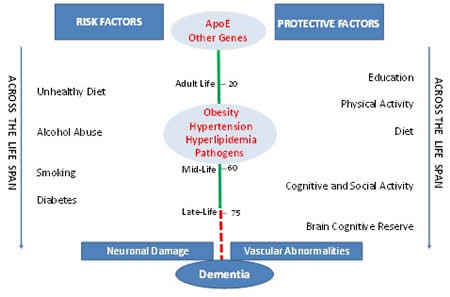
Figure 1: Risk Factors and Protective Factors
Dementia and AD are multifactorial disorders (Figure 1). Hypotheses regarding the cause of dementia have also changed over time. As recently as the 1960s, a vascular aetiology was the prevailing view, while now it is increasingly reported that mixed pathology dementias account for half or more of all dementia cases, with beta-amyloid and vascular disease constituting the most frequent combination of pathologies. Atherosclerosis, arteriosclerosis, micro-infarcts, silent stroke, and diffuse white matter disease are all associated with increased risk of dementia. Recent evidence suggests an association between mid-life hypertension, a major risk factor for stroke and diffuse white matter disease, and mid-life obesity with future risk of dementia.
Dementia can be caused by:
- Cerebrovascular diseases (Silent stroke, micro-infarcts, arteriosclerosis)
- TBI
- Hypertension
- AD
In all these conditions an increased burden of beta amyloid occurs and neuro-inflammations ensues.
The most common cause of dementia is Alzheimer´s disease (AD).[7] Diverse environmental factors, cerebrovascular dysfunction, and epigenetic phenomena, together with structural and functional genomic dysfunctions lead to amyloid deposition, neurofibrillary tangle formation and premature neuronal death, the major neuro-pathological hallmarks of AD.[8]
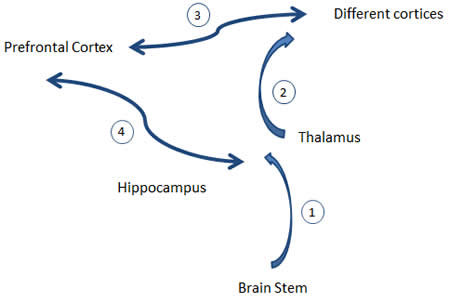
Figure 2. Steps in Creation of Short Term and Long Term Memory
To understand Alzheimer´s disease pathogenesis, Figure 2 provides a schematic illustration on the anatomical basis. Essentially, sensory information (e.g. vision, touch, taste) first pass through the brain stem to the thalamus (Step 1), which acts like a relay station, directing the signals to the various sensory lobes of the brain (Step 2), where they are evaluated. The processed information reaches the prefrontal cortex (Step 3), where it enters the consciousness and forms our short-term memory, which can range from several seconds to minutes.[9]
To store information for a longer duration, these are broken down into different categories in the hippocampus (Step 4), where the fragments are redirected to various cortical structures. For instance, emotional memories are stored in the amygdale, but words are recorded in the temporal lobe. Meanwhile, colours and other visual information are collected in the occipital lobe, and the sense of touch and movement reside in the parietal lobe.[10] The ultimate goal of research focusing on learning and memory processes is, then, to figure out how these scattered fragments are somehow reassembled when we recall an ‘experience’. This is called the “binding problem”. Elevated β-amyloid and impaired synaptic function in hippocampus are among the earliest manifestations of Alzheimer's disease (AD). Most cognitive assessments employed in both humans and animal models, however, are insensitive to this early disease pathology. One critical aspect of hippocampal function is its role in episodic memory, which involves the binding of temporally coincident sensory information (e.g., sights, smells, and sounds) to create a representation of a specific learning epoch. Flexible associations can be formed among these distinct sensory stimuli that enable the "transfer" of new learning across a wide variety of contexts. Thus, understanding this “binding problem” could potentially unravel novel targets for more efficient therapeutic approach to AD-derived dementia.[11-15]
Alzheimer's disease (AD) is an age-related neurodegenerative disease of the central nervous system correlated with the progressive loss of cognition and memory. β-Amyloid plaques, neurofibrillary tangles and the deficiency in cholinergic neurotransmission constitute the major hallmarks of the AD.[16,17] Two major hypotheses have been implicated in the pathogenesis of AD. namely the cholinergic hypothesis which ascribed the clinical features of dementia to the deficit cholinergic neurotransmission and the amyloid cascade hypothesis which emphasized on the deposition of insoluble peptides formed due to the faulty cleavage of the amyloid precursor protein. Current pharmacotherapy includes mainly the acetylcholinesterase inhibitors and N-methyl-D-aspartate receptor agonist which offer symptomatic therapy and does not address the underlying cause of the disease. The disease-modifying therapy has garnered a lot of research interest for the development of effective pharmacotherapy for AD. β and γ-Secretase constitute attractive targets that are focused in the disease-modifying approach. Potentiation of α-secretase also seems to be a promising approach towards the development of an effective anti-Alzheimer therapy. Additionally, the ameliorative agents that prevent aggregation of amyloid peptide and also the ones that modulate inflammation and oxidative damage associated with the disease are focused upon. On the other hand, development in the area of the vaccines is in progress to combat the characteristic hallmarks of the disease.[18]
The genetic, cellular, and molecular changes associated with Alzheimer disease provide evidence of immune and inflammatory processes involvement in its pathogenesis. These are supported by epidemiological studies, which show some benefit of long-term use of NSAID. The hypothesis that AD is in fact an immunologically mediated and even inflammatory pathological process may be in fact scientifically intriguing. There are several obstacles that suggest the need for more complex view, in the process of targeting inflammation and immunity in AD. In 2000, researchers led by Dr Frank M LaFerla at the Department of Neurobiology and Behavior at the University of California Irvine, Irvine, USA, demonstrated that a synthetic protein that resembles the Herpes Simplex Virus (HSV-1) mimics the structure and function of a protein called β-amyloid, the toxic agent that accumulates in the brains of Alzheimer patients.[18,19] Moreover, genetic sequencing revealed that two-thirds of the viral protein is identical to the β-amyloid protein, and also, the viral protein generates abnormally twisted fibers similar to those found in AD brain brains (neurofibrillary tangles, formed of hyper-phosphorylated ‘tau’ protein) representing one of the hallmark of the disease.[19,20]
Several data indicate that neuronal infection with herpes simplex virus type 1 (HSV-1) causes biochemical alterations reminiscent of Alzheimer's disease (AD) phenotype. They include accumulation of amyloid-β (Aβ), which originates from the cleavage of amyloid precursor protein (APP), and hyper-phosphorylation of tau protein, which leads to neurofibrillary tangle deposition. HSV-1 infection triggers APP processing and drives the production of several fragments including APP intracellular domain (AICD) that exerts trans-activating pro-inflammatory properties. Although a recent study indicated unequivocally lack of evidence for a role of HHV-6 in the pathogenesis of Alzheimer's disease,[21] still there are evidence indicating that, for instance, HSV-1 infection might induce early upstream events in the cell that may eventually lead to Aβ deposition and tau hyper-phosphorylation and further suggest HSV-1 as a possible risk factor for AD.[22-27]
Increasing evidence indicates that aspirin-triggered Lipoxin A4 (LXA4) (15 μg/kg) s c, twice a day, reduced both NF-kB activation and levels of pro-inflammatory cytokines and chemokines, as well as increased levels of anti-inflammatory IL-10 and transforming growth factor B (beta). Basically, LXA4 seems to reduce brain inflammation.[28] Such changes in the cerebral milieu resulted in recruitments of microglia in an alternative phenotype as characterized by the up-regulation of Ym1 and arginase-1 and the down-regulation of inducible nitric oxide synthase expression.[10] In effect, the researchers contend that activating LXA4 signaling may represent a novel therapeutic approach for AD.[28] Given the potential gastrointestinal discomfort associated with aspirin intake, is there another manner to increase LXA4 in the brain as well as provide both anti-viral protection and anti-oxidant protection?
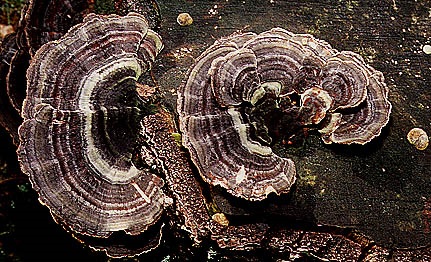
Coriolus versicolor
Why Mushroom Nutrition?
In the past ten years, the clinical development of mushroom nutrition has determined that Coriolus versicolor (biomass) has viral protective properties, while Hericium erinaceus (biomass) is extremely high in SOD content. Consistent with this notion Coriolus versicolor biomass has a clinically verified use in the reduction of viral load of EBV, CMV and HHV-6. These viruses are related to the onset of Chronic Fatigue Syndrome condition.[29,30] In addition, Coriolus versicolor has been used to increase the regression rate of LSIL lesions in HPV patients and to significantly reduce the viral load in HPV patients.[31]
Hericium erinaceus biomass has an extremely high super-oxide dismutase (SOD) content , which in the presence of in vitro proteolytic enzymes (per 500 mg tablet) has a SOD content of 19.430 10³ U.[32] This high SOD content is important given that with Herpes Simplex virus infection, apoE4 intensifies virus latency and is associated with the increased oxidative damage to the central nervous system. In addition there is some evidence that herpes simplex virus infection in combination with the apoE4 genotype may be associated with increased risk of Alzheimer´s disease (AD).[33]
Assessing the Capacity of Coriolus versicolor to Increase LXA4
LXA4, a metabolic product of arachidonic acid, is considered an endogenous ‘stop signal’ for inflammation and demonstrates strong anti-inflammatory properties in many inflammatory disorders, such as nephritis, periodontitis or arthritis.[34] Chronic brain inflammation sustains the progression of Alzheimer´s disease, so the objective is to find molecules that can reduce brain inflammation; thereby providing a disease-modifying therapy for dementia.
Researchers in the University of Catania and the University of Messina conducted research to determine if Coriolus versicolor biomass stimulates Lipoxin A4 (LXA4) activation in peripheral blood and in the CNS of rats treated with an equivalent human dose of 3g per day given, orally. One group of rats were supplemented with Coriolus versicolor biomass and another group (Control) that was not supplemented over 30 days (N=10).[35]
At the end of experimental period animals were sacrificed and the activity of LXA4 was determined in serum, lymphocytes and in different brain regions (cortex, striatum, substantia nigra, hippocampus and cerebellum) and compared with LXA4 of untreated animals, as control.[35]
The researchers focused on the impact of Coriolus supplementation on redox-dependent genes, called vitagenes, including heat shock proteins (Hsps), sirtuins, thioredoxin and lipoxin A4 (LXA4). The differences in the up-regulation of the following vitagenes were measured:
a. Lipoxin A4 (LXA4)
b. Heme Oxygenase-1 (HO-1);
c. Heat Shock Protein 70 (Hsp 70).
d. Thioredoxin
LXA4
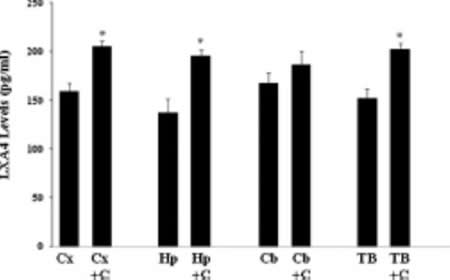
Fig 3 Bar Chart LXA4
Fig. 3. Regional distribution of Lipoxin A4 protein levels in different brain regions and in total brain of control or Coriolus-fed rats. Values are expressed as mean SEM of three independent analyses on 10 animals per group. CX: cortex; Hp: hippocampus; Cb: cerebellum; TB: total brain. C: Coriolus, given orally at the dose of 200 mg/kg for 30 days.
As outlined in Figure 3, higher levels of LXA4 protein expression was observed in cortex and cerebellum, followed with a statically significant difference by striatum, hippocampus and septum, whereas the lowest levels were found in the substantia nigra.
Administration of Coriolus versicolor for 30 days at the oral daily dose of 200 mg/kg induced an increase in the protein levels of LXA4 in all brain regions examined. This effect was significant (P<0.05) in the cortex, hippocampus and in the total brain compared to control group, but not in the cerebellum.
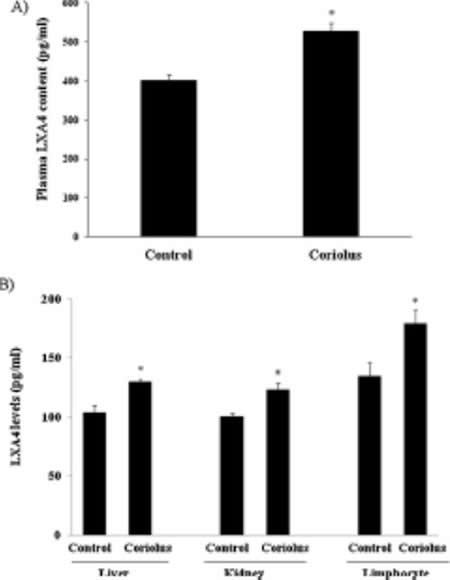
Fig 4 LXA4 Levels
Fig. 4. (A) LXA4 levels in plasma from rats fed Coriolus biomass preparation as compared to the control group. Data are expressed as mean SEM of 10 animals per group. *P < 0.05 vs controls; (B) LXA4 levels in liver, kidney and in lymphocytes from rats fed Coriolus biomass preparation as compared to control group. Data are expressed as mean SEM of 10 animals per group. *P < 0.05 vs controls.
As outlined in Figure 4, animals receiving chronic administration of Coriolus compared to untreated controls, brain changes in LXA4 protein were associated with a significant (P<0.05) increase in plasma (Figure 4 A), lymphocytes and peripheral organs, such as liver and kidney (4B).
Heme Oxygenase-1
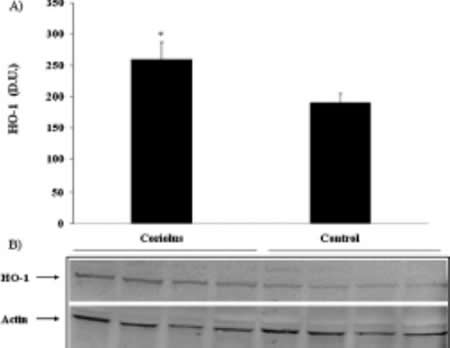
Fig 5 Heme oxygenase-1
Fig. 5. Heme oxygenase-1 protein levels in the brain of rats fed Coriolus biomass preparation as compared to the control group. Total brain homogenates from control and mushroom-supplemented rats were assayed for HO-1 expression by Western blot. (A) Densitometric evaluation: the bar graph shows the values are expressed as mean standard error of mean of three independent analyses. P < 0.05 vs control. (B) A representative immunoblot is shown. b-Actin has been used as loading control. D.U., densitometric units.
As demonstrated in Figure 5, Coriolus supplementation resulted in up-regulation of brain cellular stress response protein heme oxygenase-1 (HO-1).
Hsp 70
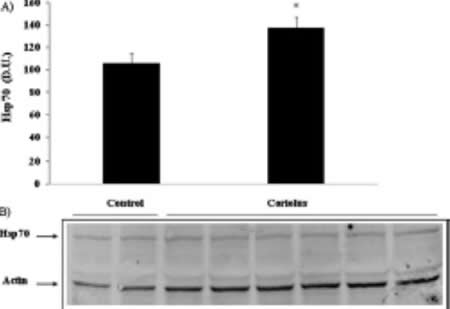
Fig 6 Hsp 70 Inducible shock protein
Fig. 6. Inducible Heat shock protein 70 protein levels in the brain of rats fed Coriolus biomass preparation as compared to control group. Total brain homogenates from control and mushroom supplemented rats were assayed for Hsp70 expression by Western blot. (A) Densitometric evaluation: the bar graph shows the values are expressed as mean standard error of mean of three independent analyses. P < 0.05 vs control. (B) A representative immunoblot is shown. b-Actin has been used as loading control. D.U., densitometric units.
Levels of Hsp 70 were significantly increased in the cortex, substantia nigra and hippocampus (Figure 6).
Impact of Coriolus supplementation on up-regulation of OH-1 and Hsp70 on Cortex, Substantia Nigra and Hippocampus
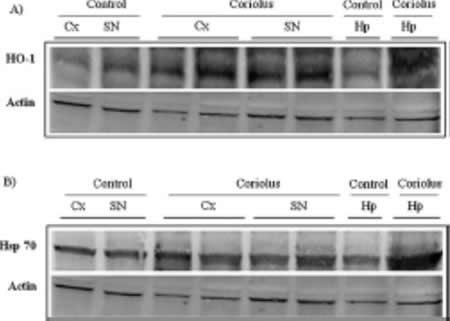
Fig 7 Representative Blots different brain regions for HO-1 and Hsp 70
Fig. 7. Representative Western blots, obtained probing the different brain regions for HO-1 (A) and, respectively Hsp70 (B) proteins. CX: cortex; Hp: hippocampus; SN: substantia nigra.
Figure 7 is a representative Western blot, obtained probing the different brain regions for HO-1 (Figure 7A) and respectively, Hsp 70 (Figure 7B) proteins, which show a significant increase of proteins levels induced by Coriolus supplementation in the cortex , substantia nigra and hippocampus.[35]
Heme Oxygenase-1 in Blood Plasma
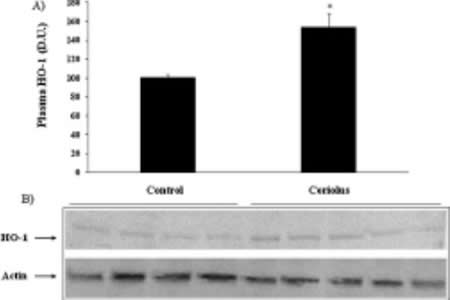
Fig 8 Heme oxygenase-1 protein levels in plasma
Fig. 8. Heme oxygenase-1 protein levels in plasma from rats fed Coriolus biomass preparation as compared to the control group. Samples from control and mushroom supplemented rats were assayed for HO-1 expression by Western blot. (A) Densitometric evaluation: the bar graph shows the values are expressed as mean standard error of mean of three independent analyses. P < 0.05 vs control. (B) A representative immunoblot is shown. b-Actin served as the loading control. D.U., densitometric units.
As outlined in Figure 8, there was a significant induction of heme oxygenase-1 in the plasma of Coriolus fed rats when compared to the Control group of rats.
Thioredoxin
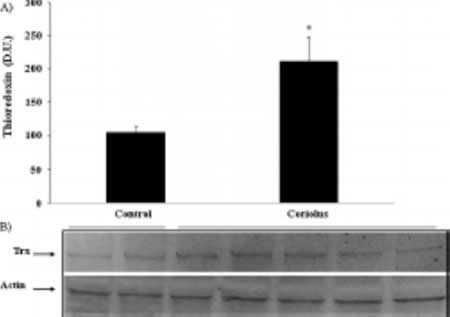
Fig 9 Thioredoxin protein levels
Fig. 9. Thioredoxin protein levels in the brain of rats fed Coriolus biomass preparation as compared to the control group. Total brain homogenates from control and mushroom-supplemented rats were assayed for thioredoxin (Trx) by Western blot. (A) Densitometric evaluation: the bar graph shows the values are expressed as mean standard error of mean of three independent analyses. P < 0.05 vs control. (B) A representative immunoblot is shown. b-Actin has been used as loading control. D.U., densitometric units.
As outlined in Figure 9, there was a significant increased expression of redox-sensitive thioredoxin in total brain homogenate of Coriolus fed rats when compared to the Control group of rats.
Conclusion
Coriolus versicolor biomass supplementation has been shown to significantly up-regulate LXA4 in the brain in rats when compared to a control group. In addition, there was a significant increase in heme oxygenase-1, Hsp 70 and thioredoxin in the total brain of Coriolus-fed rats when compared to a control group.[35]
These results could have implications for the development of a mushroom nutrition based, disease-modifying therapy, for the treatment of Alzheimer´s disease. The next step is to construct a clinical trial that provides a ‘proof of concept’ in patients. This finding has been further refined and consolidated in a subsequent study indicating the powerful therapeutic potential of a supplementation with mushroom nutrition in the control of neuroinflammatory alterations sustaining the pathogenesis of Alzheimer’s disease with potential impact on the course and the progression of the disease.[36]
Note: The Coriolus versicolor biomass was supplied by Mycology Research Laboratories Ltd.-United Kingdom. (www.mycologyresearch.com)
References
1. Knopman DS, Jack CR Jr, Wiste HJ, Weigand SD, Vemuri P, Lowe VJ, Kantarci K, Gunter JL, Senjem ML, Mielke MM, Machulda MM, Roberts RO, Boeve BF, Jones DT, Petersen RC. Age and neurodegeneration imaging biomarkers in persons with Alzheimer disease dementia. Neurology. pii: 10.1212/WNL.0000000000002979. Jul 15 2016.
2. World Alzheimer Report 2015, The Global Impact of Dementia: An Analysis of Prevalence, Incidence, Cost and Trends. Alzheimer Disease International, London. Chapter 2, p22. August 2015
3. World Alzheimer Report 2015, The Global Impact of Dementia: An Analysis of Prevalence, Incidence, Cost and Trends.Alzheimer Disease International, London. Chapter 6, p58. August 2015.
4. World Alzheimer Report 2015, The Global Impact of Dementia: An Analysis of Prevalence, Incidence, Cost and Trends.Alzheimer Disease International, London. Chapter 5, p53. August 2015.
5. World Alzheimer Report 2015, The Global Impact of Dementia: An Analysis of Prevalence, Incidence, Cost and Trends.Alzheimer Disease International, London. Chapter 7, p78. August 2015.
6. Trovato A, Siracusa R, Di Paola R, Scuto M, Ontario ML, Bua O, Di Mauro P, Toscano MA, Petralia CC, Maiolino L, Serra A, Cuzzocrea S, Calabrese V. Redox modulation of cellular stress response and lipoxin A4 expression by Hericium Erinaceus in rat brain: relevance to Alzheimer's disease pathogenesis. Immun Ageing. 13:23. doi: 10.1186/s12979-016-0078-8. Jul 9 2016.
7. Garwood CJ, Ratcliffe LE, Simpson JE, Heath PR, Ince PG, Wharton SB. Review: Astrocytes in Alzheimer's disease and other age-associated dementias; a supporting player with a central role. Neuropathol Appl Neurobiol. doi: 10.1111/nan.12338. Jul 21 2016.
8. Sindi S, Mangialasche F, Kivipelto M. Advances in the prevention of Alzheimer's Disease. F1000Prime Rep. 7:50. doi: 10.12703/P7-50. May 12 2015.
9. Kaku M. The Future of the Mind, Allen Lane division of Penguin Press Ltd. Chapter 5, p106. ISBN:978-1-846-14767-8.
10. Horvát S, Gămănuț R, Ercsey-Ravasz M, Magrou L, Gămănuț B, Van Essen DC,Burkhalter A, Knoblauch K, Toroczkai Z, Kennedy H. Spatial Embedding and Wiring Cost Constrain the Functional Layout of the Cortical Network of Rodents and Primates. PLoS Biol. 14(7):e1002512. doi:10.1371/journal.pbio.1002512. Jul 21 2016.
11. Hampel H, Schneider LS, Giacobini E, Kivipelto M, Sindi S, Dubois B, Broich K, Nisticò R, Aisen PS, Lista S. Advances in the therapy of Alzheimer's disease: targeting amyloid beta and tau and perspectives for the future. Expert Rev Neurother. 15:83-105. 2015.
12. Davinelli S, Calabrese V, Zella D, Scapagnini G. Epigenetic nutraceutical diets in Alzheimer's disease. J Nutr Health Aging. 18:800-805. 2014.
13. Cornelius C, Koverech G, Crupi R, Di Paola R, Koverech A, Lodato F, Scuto M, Salinaro AT, Cuzzocrea S, Calabrese EJ, Calabrese V. Osteoporosis and Alzheimer pathology: Role of cellular stress response and hormetic redox signaling in aging and bone remodeling. Front Pharmacol. 2014 Jun 10;5:120. doi:10.3389/fphar.2014.00120.
14. Calabrese V, Sultana R, Scapagnini G, Guagliano E, Sapienza M, Bella R, Kanski J, Pennisi G, Mancuso C, Stella AM, Butterfield DA. Nitrosative stress, cellular stress response, and thiol homeostasis in patients with Alzheimer's disease. Antioxid Redox Signal. 8: 1975-1986. 2006.
15. Siciliano R, Barone E, Calabrese V, Rispoli V, Butterfield DA, Mancuso C.
Experimental research on nitric oxide and the therapy of Alzheimer disease: a challenging bridge. CNS Neurol Disord Drug Targets. 7:766-776. 2011.
16. Mancuso C, Bates TE, Butterfield DA, Calafato S, Cornelius C, De Lorenzo A, Dinkova Kostova AT, Calabrese V. Natural antioxidants in Alzheimer's disease. Expert Opin Investig Drugs. 16: 1921-1931. 2007.
17. Cornelius C, Trovato Salinaro A, Scuto M, Fronte V, Cambria MT, Pennisi M,Bella R, Milone P, Graziano A, Crupi R, Cuzzocrea S, Pennisi G, Calabrese V. Cellular stress response, sirtuins and UCP proteins in Alzheimer disease: role of vitagenes. Immun Ageing. 10(1):41. doi: 10.1186/1742-4933-10-41. Oct 17 2013.
18. Yu YZ, Liu S, Wang HC, Shi DY, Xu Q, Zhou XW, Sun ZW, Huang PT. A novel recombinant 6Aβ15-THc-C chimeric vaccine (rCV02) mitigates Alzheimer's disease-like pathology, cognitive decline and synaptic loss in aged 3 × Tg-AD mice. Sci Rep. 6:27175. doi: 10.1038/srep27175. Jun 3 2016.
19. American Chemical Society. New Evidence Found Linking Herpes and Alzheimer’s. Science Daily. Retrieved July 26 2013, from www.sciencedaily.com/releases/2000/05/000512083302.htm . May 2000.
20. University of Manchester. Cold Sore Virus Linked To Alzheimer’s Disease: New Treatment, Or Even Vaccine Possible. Science¬Daily. Retrieved July 26 2013, from www.sciencedaily.com/releas-es/2008/12/081207134109.htm . December 7 2008.
21. Agostini S, Mancuso R, Baglio F, Cabinio M, Hernis A, Guerini FR, Calabrese E, Nemni R, Clerici M. Lack of evidence for a role of HHV-6 in the pathogenesis of Alzheimer's disease. J Alzheimers Dis. 49:229-235. 2015.
22. Wozniak MA, Mee AP, Itzhaki RF. Herpes simplex virus type I DNA is located within Alzheimer’s disease amyloid plaques. The Journal of Pathology. Volume 217. Issue 1, pp131-138. DOI: 10.1002/path.2449. 2009.
23. Kulshreshtha A, Piplani P. Current pharmacotherapy and putative disease-modifying therapy for Alzheimer's disease. Neurol Sci. [Epub ahead of print] Review. PubMed PMID: 27250365. Jun 1 2016.
24. Mancuso R, Baglio F, Agostini S, Cabinio M, Laganà MM, Hernis A, Margaritella N, Guerini FR, Zanzottera M, Nemni R, Clerici M. Relationship between herpes simplex virus-1-specific antibody titers and cortical brain damage in Alzheimer's disease and amnestic mild cognitive impairment. Front Aging Neurosci. 6:285. doi: 10.3389/fnagi.2014.00285. 2014.
25. Wozniak MA, Frost AL, Preston CM, Itzhaki RF. Antivirals reduce the forma¬tion of key Alzheimer´s disease molecules in cell cultures acutely infected with herpes simplex virus type 1. PLoS One. 2011:6(10) e25152 doi 10 1371/ journal. pone.0025152. EPUB Oct 7 2011.
26. Pandley JP. Immunoglobulin GM genese as functional risk and protective fac¬tors for the development of Alzheimer´s disease. J. Alzheimers Dis.17(4) 753-6 doi 10.3222/JAD-2009-1094. 2009.
27. Wozniak MA, Itzhaki RF. Intravenous immunoglobulin reduces amyloid and abnormal tau formation caused by herpes simplex virus type 1. J Neuroimmunol. 2013 Apr 15:257 (1-2):7-12 doi 10. 1016/ jnmeuroim 2013.01.005 Epub Feb 4 2013.
28. Medeiros R, Kitazawa M, Passos GF, Baglietto-Vargas D, Cheng D, Cribbs OH, LaFerla FM. Aspirin-triggered lipoxin A4 stimulates alternative activation of microglia and reduces Alzheimer disease-like pathology in mice. Am J Pathol. 182(5);1740-9. May 2013.
29. Monro JA. Chronic Fatigue Immune Dysfunction Syndrome. Journal of Integrative Medicine. 8:101-108. 2004.
30. Monro JA. Treatment of Cancer with Mushroom Products. Arch Env Health. 58:533-537. 2003.
31. Silva Couto J, Pereira da Silva D. Evaluation of the Efficacy of Coriolus versicolor Supplementation in HPV Lesions (LSIL) . Poster presented at the 20th European Congress of Obstetrics and Gynecology, Lisbon, Portugal. March 4-8th 2008.
32. Cornelius C, Cavallaro M, Cambria MT, Toscano MA, Calabrese V. Com¬parative Enzyme Analysis of Polyporus umbellatus, Agaricus blazei, Pleurotus ostreatus and Hericium erinaceus . Clinical Journal of Mycology Vol II. Pp4-7. 2009.
33. Kulmann I, Minihane AM, Huebbe P, Nebel A , Rimbach G. Apolipoprotien E genotype and hepatitis C, HIV and herpes simplex disease risk: a literature review. Lipids Health Dis. 28.9.8 doi 10.1186/1476-511-9.6. January 2010.
34. Medeiros R, Kitazawa M, Passos GF, Baglietto-Vargas D, Cheng D, Cribbs OH, LaFerla FM. Aspirin-triggered lipoxin A4 stimulates alternative activation of microglia and reduces Alzheimer disease-like pathology in mice. Am J Pathol. 182(5);1740-9. May 2013.
35. Trovato A, Siracusa R, Di Paola R, Scuto M,Fronte V, Koverech C, Luca M, Serra A, Toscano M.A., Petralia A, Cuzzocrea S, Calabrese V. Redox modulation of cellular stress response and lipoxin A4 expression by Coriolus versicolor in rat brain: Relevance to Alzheimer´s disease pathogenesis. Neurotoxicology. 53:350-8. doi: 10.1016/j.neuro.2015.09.012. 2016.
36. Trovato A, Siracusa R, Di Paola R, Scuto M, Ontario ML, Bua O, Di Mauro P, Toscano MA, Petralia CC, Maiolino L, Serra A, Cuzzocrea S, Calabrese V. Redox modulation of cellular stress response and lipoxin A4 expression by Hericium Erinaceus in rat brain: relevance to Alzheimer's disease pathogenesis. Immun Ageing. 13:23. doi: 10.1186/s12979-016-0078-8. Jul 9 2016.
Comments:
-
No Article Comments available